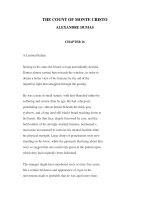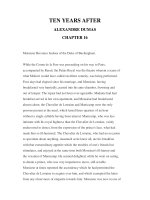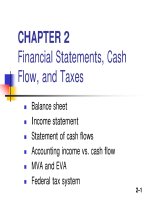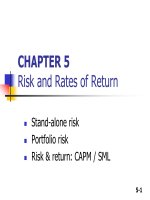Slide Financial Management - Chapter 16 pps
Bạn đang xem bản rút gọn của tài liệu. Xem và tải ngay bản đầy đủ của tài liệu tại đây (109.72 KB, 24 trang )
16-1
CHAPTER 16
Financing Current Assets
Working capital financing
policies
A/P (trade credit)
Commercial paper
S-T bank loans
16-2
Working capital financing policies
Moderate – Match the maturity of the
assets with the maturity of the
financing.
Aggressive – Use short-term financing
to finance permanent assets.
Conservative – Use permanent capital
for permanent assets and temporary
assets.
16-3
Moderate financing policy
Years
Lower dashed line would be more aggressive.
$
Perm C.A.
Fixed Assets
Temp. C.A.
S-T
Loans
L-T Fin:
Stock,
Bonds,
Spon. C.L.
16-4
Conservative financing policy
$
Years
Perm C.A.
Fixed Assets
Marketable
securities
Zero S-T
Debt
L-T Fin:
Stock,
Bonds,
Spon. C.L.
16-5
Short-term credit
Any debt scheduled for repayment within one
year.
Major sources of short-term credit
Accounts payable (trade credit)
Bank loans
Commercial loans
Accruals
From the firm’s perspective, S-T credit is
more risky than L-T debt.
Always a required payment around the corner.
May have trouble rolling over loans.
16-6
Advantages and disadvantages of
using short-term financing
Advantages
Speed
Flexibility
Lower cost than long-term debt
Disadvantages
Fluctuating interest expense
Firm may be at risk of default as a result of
temporary economic conditions
16-7
Accrued liabilities
Continually recurring short-term
liabilities, such as accrued wages or
taxes.
Is there a cost to accrued liabilities?
They are free in the sense that no
explicit interest is charged.
However, firms have little control over
the level of accrued liabilities.
16-8
What is trade credit?
Trade credit is credit furnished by a firm’s
suppliers.
Trade credit is often the largest source of
short-term credit, especially for small
firms.
Spontaneous, easy to get, but cost can
be high.
16-9
The cost of trade credit
A firm buys $3,000,000 net ($3,030,303
gross) on terms of 1/10, net 30.
The firm can forego discounts and pay on
Day 40, without penalty.
Net daily purchases = $3,000,000 / 365
= $8,219.18
16-10
Breaking down net and gross
expenditures
Firm buys goods worth $3,000,000. That’s
the cash price.
They must pay $30,303 more if they don’t
take discounts.
Think of the extra $30,303 as a financing
cost similar to the interest on a loan.
Want to compare that cost with the cost of
a bank loan.
16-11
Breaking down trade credit
Payables level, if the firm takes discounts
Payables = $8,219.18 (10) = $82,192
Payables level, if the firm takes no discounts
Payables = $8,219.18 (40) = $328,767
Credit breakdown
Total trade credit $328,767
Free trade credit - 82,192
Costly trade credit $246,575
16-12
Nominal cost of costly trade credit
The firm loses 0.01($3,030,303)
= $30,303 of discounts to obtain
$246,575 in extra trade credit:
k
NOM
= $30,303 / $246,575
= 0.1229 = 12.29%
The $30,303 is paid throughout the
year, so the effective cost of costly
trade credit is higher.
16-13
Nominal trade credit cost formula
12.29%
0.1229
10 - 40
365
99
1
period Disc. - taken Days
days 365
%Discount - 1
%Discount
k
NOM
=
=
×=
×=
16-14
Effective cost of trade credit
Periodic rate = 0.01 / 0.99 = 1.01%
Periods/year = 365 / (40-10) = 12.1667
Effective cost of trade credit
EAR = (1 + periodic rate)
n
–1
= (1.0101)
12.1667
–1 = 13.01%
16-15
Commercial paper (CP)
Short-term notes issued by large, strong
companies. B&B couldn’t issue CP it’s
too small.
CP trades in the market at rates just
above T-bill rate.
CP is bought with surplus cash by banks
and other companies, then held as a
marketable security for liquidity purposes.
16-16
Bank loans
The firm can borrow $100,000 for 1
year at an 8% nominal rate.
Interest may be set under one of the
following scenarios:
Simple annual interest
Discount interest
Discount interest with 10% compensating
balance
Installment loan, add-on, 12 months
16-17
Must use the appropriate EARs to
evaluate the alternative loan terms
Nominal (quoted) rate = 8% in all cases.
We want to compare loan cost rates and
choose lowest cost loan.
We must make comparison on EAR =
Equivalent (or Effective) Annual Rate basis.
16-18
Simple annual interest
“Simple interest” means no discount or
add-on.
Interest = 0.08($100,000) = $8,000
k
NOM
= EAR = $8,000 / $100,000 = 8.0%
For a 1-year simple interest loan, k
NOM
= EAR
16-19
Discount interest
Deductible interest = 0.08 ($100,000)
= $8,000
Usable funds = $100,000 - $8,000
= $92,000
INPUTS
OUTPUT
N I/YR PMTPV FV
1
8.6957
0 -10092
16-20
Raising necessary funds with a
discount interest loan
Under the current scenario, $100,000 is
borrowed but $8,000 is forfeited
because it is a discount interest loan.
Only $92,000 is available to the firm.
If $100,000 of funds are required, then
the amount of the loan should be:
Amt borrowed = Amt needed / (1 – discount)
= $100,000 / 0.92 = $108,696
16-21
Discount interest loan with a
10% compensating balance
$121,951
0.1-0.08-1
$100,000
balance comp. -discount - 1
neededAmount
borrowedAmount
==
=
Interest = 0.08 ($121,951) = $9,756
Effective cost = $9,756 / $100,000 = 9.756%
16-22
Add-on interest on a 12-month
installment loan
Interest = 0.08 ($100,000) = $8,000
Face amount = $100,000 + $8,000 = $108,000
Monthly payment = $108,000/12 = $9,000
Avg loan outstanding = $100,000/2 = $50,000
Approximate cost = $8,000/$50,000 = 16.0%
To find the appropriate effective rate, recognize
that the firm receives $100,000 and must make
monthly payments of $9,000. This constitutes an
annuity.
16-23
Installment loan
From the calculator output below, we have:
k
NOM
= 12 (0.012043)
= 0.1445 = 14.45%
EAR = (1.012043)
12
–1 = 15.45%
INPUTS
OUTPUT
N I/YR PMTPV FV
12
1.2043
-9 0100
16-24
What is a secured loan?
In a secured loan, the borrower pledges
assets as collateral for the loan.
For short-term loans, the most commonly
pledged assets are receivables and
inventories.
Securities are great collateral, but
generally not available.









